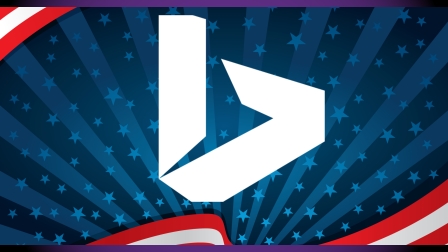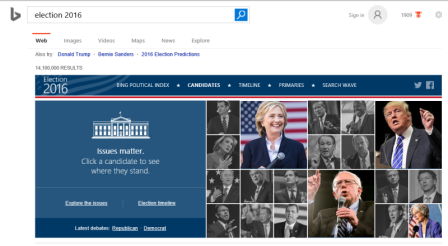The Election: More searchers, more opportunities
Columnist John Cosley of Bing discusses how advertisers can leverage election searches for paid search wins.

In December 2015, Bing rolled out an Election 2016 experience, with data powered by Bing Predicts. You’ll know Bing Predicts as the crew that’s responsible for tearing it up at the Oscars, the NBA playoffs and the Scottish independence referendum (among others) with strikingly accurate predictions.

While the Predicts experiences have never been intended as an opportunity for advertisers, the reality is that on average they result in a 50-percent increase in search traffic year over year for those related terms and a 20-percent lift in “likelihood to use” Bing against Google in perception surveys.
As a marketer, I look at this as an opportunity. So I decided to dig into the Bing Elections 2016 experience to see what makes sense for advertisers who are looking for more volume. Here’s what I found out:
1. The Elections 2016 experience on Bing is incredibly engaging
This means searchers are apt to spend more time on the search engine results page (SERP). Not just content to merely predict the winners of the primaries, Bing has created a complete picture that will answer people’s questions about the election. Where do the candidates stand on the issues? What are the issues? Where do the states stand on the issues? Who is searching for Bernie Sanders in Nevada?
For each candidate, you can see trending topics from Twitter and searches over time, which tells you what’s being said about them. All of these questions are about sentiment; in order to capture Virginia’s sentiment on health care, for example, Bing is pulling in signals from publicly available social data, from searches on Bing and from opted-in browser sessions. (It goes without saying that this data is anonymized — but I’ll say it anyway.)
This modeling gives an incredibly accurate and complete picture of sentiment, which is what makes the Elections 2016 experience so engaging. I spent close to 30 minutes just exploring the tool. And the entire time I did that, I was on the SERP, which included relevant paid search advertising with high potential for click-through, given the quality of the results on the page.
2. There is ample opportunity for advertisers
Oddly, few advertisers are bidding on queries related to the election. This means there is very little competition for this space where we’re seeing more searchers and where they’re spending more time. If this isn’t an opportunity, I don’t know what is.
3. Search volume is relatively high
The Bing team did some research into searcher use of election and politics terms — and naturally found a 29-percent leap in demand year over year. Queries that are specific to the election would naturally be higher during the election cycle.

While these are the top 20 elections-related queries for April, you’ll want to note that many of these terms would not be top searches in June. And that’s the fourth thing I learned about optimizing paid search campaigns for the election cycle…
4. Search terms change but are still predictable
Top queries will change from one month to the next, and even from one week to the next, as the election cycle impacts candidates, topics, states and issues. This makes your election audience a moving, but predictable, target.
Acting on the research
From the four key observations above, we can see some clear opportunities for paid search marketers who want access to the increased audience size that election queries give us. We can break these opportunities into the following areas:
- Obvious matches between advertisers and election queries
- Creative messaging for any advertiser using election queries
- Strategic considerations: Quality Score, campaign structure and exact match
Obvious matches between advertisers and election queries
There is currently very little competition on both Google and Bing for keywords related to the top issues around the election. But all of these top issues have a clear connection to businesses or services, as seen in the chart below:
| Election topic | Advertiser |
|---|---|
| Drug Policy | Rehab and recovery centers, therapists, health care |
| Education policy | Colleges, technical schools, trade schools |
| Environmental issues | Environmental attorney, colleges with environmental studies, eco retail |
| Gun control | Hunting and outdoor, accessories and storage |
| Healthcare | Colleges with medical focus, technical and trade schools, health insurance companies |
| Immigration reform | Immigration attorney |
| LGBT rights | Civil rights attorneys, health care, retail |
| Social Security | Health care, retirement community |
| Tax reform | Tax filing preparation, financial services, estate planning, life insurance, tax attorney |
Do you have clients in the above verticals? Consider the increase in audience you can get with these low-competition keywords. Test your ads in this environment and see what you end up with.
Creative messaging for any advertiser using election queries
To capture searchers active on the keywords of the moment (rather than the issue keywords above, which won’t change much throughout the election season), advertisers need only to combine a couple of elements for success:
- Pay attention to the election news to be aware of terms that your audience will be searching.
- Get creative with your messaging.
Here’s an example:

Or, on of-the-moment keywords like [Hillary Clinton emails]:

With enough creative thought, there is almost an endless string of advertisers and creative messaging that would work for election queries. Think of pizza delivery, on a query like [Trump VP pick]: “Hungry for change? We’ll be right there.” Or for an outdoor clothing company, on a term like [primary results]: “Weather the storm in a lightweight rain jacket.”
Strategic considerations: Quality Score, campaign structure and exact match
To make a project like this work, there are some strategic considerations that will keep you on the right track.
Quality Score. Of course, you’ll want to be mindful of your Quality Score because you’re experimenting for the first time with an election audience. To help get max relevancy on Quality Score, make sure your landing page is relevant to the election experience as well. It’s not enough to have creative ad copy that fits the queries; adjust the landing page to include relevant election information so your Quality Score remains higher.
Campaign structure. Create a separate campaign for the election category that is specific to this experience. Keep it separate from your other campaigns so you can accurately evaluate results. Separating it like this will also prevent you from getting messages mixed up, since you’ll be developing new, creative ad copy that might only make sense in the context of the election queries.
Exact match. Because election queries are pretty specific (“California primary” doesn’t mean anything except “California primary”), broad match wouldn’t work well for this campaign. Exact and phrase match will be your workhorses.
Polling results say…
These are interesting times, and this election cycle is creating a thirst for information, causing searchers to dive for the search bar. Whether they end up on the Bing Election 2016 experience or not, they’re querying the election. Right now, very few advertisers are targeting this audience. Give it a go and let me know your results. I’d love to hear.
[Article on Search Engine Land.]
Some opinions expressed in this article may be those of a guest author and not necessarily Marketing Land. Staff authors are listed here.
Marketing Land – Internet Marketing News, Strategies & Tips
(11)


